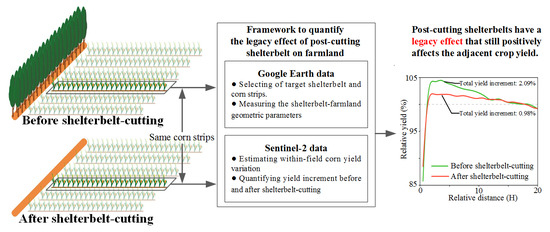Estimating the Legacy Effect of Post-Cutting Shelterbelt on Crop Yield Using Google Earth and Sentinel-2 Data
Abstract
1. Introduction
2. Study Area, Data, and Methods
2.1. Study Area
2.2. Data
2.3. Methods
2.3.1. Selection of Target Shelterbelt and Corn Strips
2.3.2. Estimation of the Corn Yield
2.3.3. Quantification of Yield Increment
2.3.4. Statistical Analysis
3. Results and Discussion
3.1. Profound Legacy Effect of Post-Cutting Shelterbelt
3.2. Stronger Legacy Effect on the Leeward Sides
3.3. The Variation of Legacy Effect of Shelterbelt across Its Density
3.4. Decompose the Microclimate and Soil Effects from the Total Yield Effect
4. Conclusions
Supplementary Materials
Author Contributions
Funding
Data Availability Statement
Conflicts of Interest
References
- Baker, T.P.; Moroni, M.T.; Hunt, M.A.; Worledge, D.; Mendham, D.S. Temporal, environmental and spatial changes in the effect of windbreaks on pasture microclimate. Agric. For. Meteorol. 2021, 297, 10. [Google Scholar] [CrossRef]
- Weninger, T.; Scheper, S.; Lackóová, L.; Kitzler, B.; Gartner, K.; King, N.W.; Cornelis, W.; Strauss, P.; Michel, K. Ecosystem services of tree windbreaks in rural landscapes—A systematic review. Environ. Res. Lett. 2021, 16, 103002. [Google Scholar] [CrossRef]
- Yuan, F.; Wu, J.; Wang, A.; Guan, D.; Zhang, Y.; Rajah-Boyer, K.I.; Xu, X. A semiempirical model for horizontal distribution of surface wind speed leeward windbreaks. Agrofor. Syst. 2020, 94, 499–516. [Google Scholar] [CrossRef]
- Grala, R.K.; Colletti, J.P. Estimates of additional Maize (Zea mays) yields required to offset costs of tree-windbreaks in Midwestern USA. Agrofor. Syst. 2003, 59, 11–20. [Google Scholar] [CrossRef]
- Osorio, R.J.; Barden, C.J.; Ciampitti, I.A. GIS approach to estimate windbreak crop yield effects in Kansas-Nebraska. Agrofor. Syst. 2019, 93, 1567. [Google Scholar] [CrossRef]
- Zheng, X.; Zhu, J.; Xing, Z. Assessment of the effects of shelterbelts on crop yields at the regional scale in Northeast China. Agric. Syst. 2016, 143, 49–60. [Google Scholar] [CrossRef]
- Li, T.S. Protecting the Breadbasket with Trees? The Effect of the Great Plains Shelterbelt Project on Agriculture. Land Econ. 2021, 97, 321–344. [Google Scholar] [CrossRef]
- Hoenig, B. In the name of the great work Stalin’s plan for the transformation of nature and its impact in eastern Europe. Rev. D Etudes Comp. Est-Ouest 2018, 49, 253–256. [Google Scholar] [CrossRef]
- Yu, K.J.; Li, D.H.; Li, N.Y. The evolution of Greenways in China. Landsc. Urban Plan. 2006, 76, 223–239. [Google Scholar] [CrossRef]
- Gardner, R. Trees as technology: Planting shelterbelts on the Great Plains. Hist. Technol. 2009, 25, 325–341. [Google Scholar] [CrossRef]
- Brain, S. The Great Stalin Plan for the transformation of nature. Environ. Hist. 2010, 15, 670–700. [Google Scholar] [CrossRef]
- Kanzler, M.; Bohm, C.; Mirck, J.; Schmitt, D.; Veste, M. Microclimate effects on evaporation and winter wheat (Triticum aestivum L.) yield within a temperate agroforestry system. Agrofor. Syst. 2019, 93, 1821–1841. [Google Scholar] [CrossRef]
- Smith, M.M.; Bentrup, G.; Kellerman, T.; MacFarland, K.; Straight, R.; Ameyaw, L. Windbreaks in the United States: A systematic review of producer-reported benefits, challenges, management activities and drivers of adoption. Agric. Syst. 2021, 187, 103032. [Google Scholar] [CrossRef]
- Guan, D.X.; Zhong, Y.; Jin, C.J.; Wang, A.Z.; Wu, J.B.; Shi, T.T.; Zhu, T.Y. Variation in wind speed and surface shear stress from open floor to porous parallel windbreaks: A wind tunnel study. J. Geophys. Res. Atmos. 2009, 114, 13. [Google Scholar] [CrossRef]
- Kuemmel, B. Theoretical investigation of the effects of field margin and hedges on crop yields. Agric. Ecosyst. Environ. 2003, 95, 387–392. [Google Scholar] [CrossRef]
- Iwasaki, K.; Torita, H.; Touze, M.; Wada, H.; Abe, T. Modeling optimal windbreak design in maise fields in cool humid climates: Balancing between positive and negative effects on yield. Agric. For. Meteorol. 2021, 308, 108552. [Google Scholar] [CrossRef]
- Arnaiz-Schmitz, C.; Herrero-Jauregui, C.; Schmitz, M.F. Losing a heritage hedgerow landscape. Biocultural diversity conservation in a changing social-ecological Mediterranean system. Sci. Total Environ. 2018, 637, 374–384. [Google Scholar] [CrossRef]
- Nelmes, S.; Belcher, R.E.; Wood, C.J. A method for routine characterisation of shelterbelts. Agric. For. Meteorol. 2001, 106, 303–315. [Google Scholar] [CrossRef]
- Peri, P.L.; Bloomberg, M. Windbreaks in southern Patagonia, Argentina: A review of research on growth models, windspeed reduction, and effects on crops. Agrofor. Syst. 2002, 56, 129–144. [Google Scholar] [CrossRef]
- Campi, P.; Palumbo, A.D.; Mastrorilli, M. Effects of tree windbreak on microclimate and wheat productivity in a Mediterranean environment. Eur. J. Agron. 2009, 30, 220–227. [Google Scholar] [CrossRef]
- Chendev, Y.G.; Gennadiev, A.N.; Lukin, S.V.; Sauer, T.J.; Zazdravnykh, E.A.; Belevantsev, V.G.; Smirnova, M.A. Change of Forest-Steppe Chernozems under the Influence of Shelterbelts in the South of the Central Russian Upland. Eurasian Soil Sci. 2020, 53, 1033–1045. [Google Scholar] [CrossRef]
- Amichev, B.Y.; Laroque, C.P.; Van Rees, K.C.J. Shelterbelt removals in Saskatchewan, Canada: Implications for long-term carbon sequestration. Agrofor. Syst. 2020, 94, 1665–1680. [Google Scholar] [CrossRef]
- Van Den Berge, S.; Vangansbeke, P.; Baeten, L.; Vanneste, T.; Vos, F.; Verheyen, K. Soil carbon of hedgerows and ‘ghost’ hedgerows. Agrofor. Syst. 2021, 95, 1087–1103. [Google Scholar] [CrossRef]
- Drexler, S.; Gensior, A.; Don, A. Carbon sequestration in hedgerow biomass and soil in the temperate climate zone. Reg. Environ. Change 2021, 21, 14. [Google Scholar] [CrossRef]
- Rivest, M.; Whalen, J.K.; Rivest, D. Variation of soil microbial and earthworm communities along an agricultural transect with tree windbreak. Agrofor. Syst. 2020, 94, 1639–1649. [Google Scholar] [CrossRef]
- Rudd, L.; Kulshreshtha, S.; Belcher, K.; Amichev, B. Carbon life cycle assessment of shelterbelts in Saskatchewan, Canada. J. Environ. Manag. 2021, 297, 11. [Google Scholar] [CrossRef]
- Karg, J.; Kajak, A.; Ryszkowski, L. Impact of young shelterbelts on organic matter content and development of microbial and faunal communities of adjacent fields. Pol. J. Ecol. 2003, 51, 283–290. [Google Scholar]
- Rivest, D.; Lorente, M.; Olivier, A.; Messier, C. Soil biochemical properties and microbial resilience in agroforestry systems: Effects on wheat growth under controlled drought and flooding conditions. Sci. Total Environ. 2013, 463, 51–60. [Google Scholar] [CrossRef]
- Canarini, A.; Schmidt, H.; Fuchslueger, L.; Martin, V.; Herbold, C.W.; Zezula, D.; Gundler, P.; Hasibeder, R.; Jecmenica, M.; Bahn, M.; et al. Ecological memory of recurrent drought modifies soil processes via changes in soil microbial community. Nat. Commun. 2021, 12, 5308. [Google Scholar] [CrossRef]
- Francis, J.L.; Andrew, F.O. Wheat yield and soil properties reveal legacy effects of artificial erosion and amendments on a dryland Dark Brown Chernozem. Can. J. Soil Sci. 2018, 98, 663–677. [Google Scholar] [CrossRef]
- Gabbarini, L.A.; Figuerola, E.; Frene, J.P.; Robledo, N.B.; Ibarbalz, F.M.; Babin, D.; Smalla, K.; Erijman, L.; Wall, L.G. Impacts of switching tillage to no-tillage and vice versa on soil structure, enzyme activities and prokaryotic community profiles in Argentinean semi-arid soils. FEMS Microbiol. Ecol. 2021, 97, fiab025. [Google Scholar] [CrossRef] [PubMed]
- Lapsansky, E.R.; Milroy, A.M.; Andales, M.J.; Vivanco, J.M. Soil memory as a potential mechanism for encouraging sustainable plant health and productivity. Curr. Opin. Biotechnol. 2016, 38, 137–142. [Google Scholar] [CrossRef] [PubMed]
- Cardinael, R.; Chevallier, T.; Cambou, A.; Beral, C.; Barthes, B.G.; Dupraz, C.; Durand, C.; Kouakoua, E.; Chenu, C. Increased soil organic carbon stocks under agroforestry: A survey of six different sites in France. Agric. Ecosyst. Environ. 2017, 236, 243–255. [Google Scholar] [CrossRef]
- Lorenz, K.; Lal, R. Soil organic carbon sequestration in agroforestry systems. A review. Agron. Sustain. Dev. 2014, 34, 443–454. [Google Scholar] [CrossRef]
- Smirnova, M.A.; Gennadiev, A.N.; Chendev, Y.G.; Kovach, R.G. Influence of Forest Shelterbelts on Local Pedodiversity (Belgorod Oblast). Eurasian Soil Sci. 2020, 53, 1195–1205. [Google Scholar] [CrossRef]
- Yu, T.; Liu, P.J.; Zhang, Q.; Ren, Y.; Yao, J.N. Detecting Forest Degradation in the Three-North Forest Shelterbelt in China from Multi-Scale Satellite Images. Remote Sens. 2021, 13, 1131. [Google Scholar] [CrossRef]
- Wang, H.; He, M.Y.; Ran, N.; Xie, D.; Wang, Q.; Teng, M.J.; Wang, P.C. China’s Key Forestry Ecological Development Programs: Implementation, Environmental Impact and Challenges. Forests 2021, 12, 101. [Google Scholar] [CrossRef]
- Wu, Z.; Yu, L.; Zhang, X.; Du, Z.; Zhang, H. Satellite-based large-scale vegetation dynamics in ecological restoration programmes of Northern China. Int. J. Remote Sens. 2019, 40, 2296–2312. [Google Scholar] [CrossRef]
- Zhu, J.J.; Zheng, X. The prospects of development of the Three-North Afforestation Program (TNAP): On the basis of the results of the 40-year construction general assessment of the TNAP. Chin. J. Ecol. 2019, 38, 1600–1610. [Google Scholar]
- Zhu, J.J.; Song, L.N. A review of ecological mechanisms for management practices of protective forests. J. For. Res. 2021, 32, 435–448. [Google Scholar] [CrossRef]
- Burke, M.W.V.; Rundquist, B.C.; Zheng, H.C. Detection of Shelterbelt Density Change Using Historic APFO and NAIP Aerial Imagery. Remote Sens. 2019, 11, 218. [Google Scholar] [CrossRef]
- Iwasaki, K.; Torita, H.; Abe, T.; Uraike, T.; Touze, M.; Fukuchi, M.; Sato, H.; Iijima, T.; Imaoka, K.; Igawa, H. Spatial pattern of windbreak effects on maize growth evaluated by an unmanned aerial vehicle in Hokkaido, northern Japan. Agrofor. Syst. 2019, 93, 1133–1145. [Google Scholar] [CrossRef]
- Deng, R.X.; Wang, W.J.; Li, Y.; Shi, X.L.; Wei, Y.C.; Hao, L.J.; Li, C.J.; Liu, W.Y. Analysis of changes in shelterbelt landscape in northeast China. Appl. Ecol. Environ. Res. 2019, 17, 11655–11668. [Google Scholar] [CrossRef]
- Niu, Q.; Li, X.; Huang, J.; Huang, H.; Huang, X.; Su, W.; Yuan, W. A 30-m annual maize phenology dataset from 1985 to 2020 in China. Earth Syst. Sci. Data Discuss. 2022, 14, 2851–2864. [Google Scholar] [CrossRef]
- Tang, X.P.; Xie, S.X.; Cui, W.S.; Wang, C.H.; Chen, Y.; Yuan, S.Q.; Wen, G.Q.; Zhou, J.M.; Chen, X.L.; Liu, J.J. Operational Regulation of Harvesting of Farmland Shelterbelt Forest; Standards Press of China: Beijing, China, 2008; Volume LY/T 1723–2008, pp. 1–16. [Google Scholar]
- Zhao, Q.; Yu, L.; Li, X.C.; Peng, D.L.; Zhang, Y.G.; Gong, P. Progress and Trends in the Application of Google Earth and Google Earth Engine. Remote Sens. 2021, 13, 3778. [Google Scholar] [CrossRef]
- Drusch, M.; Del Bello, U.; Carlier, S.; Colin, O.; Fernandez, V.; Gascon, F.; Hoersch, B.; Isola, C.; Laberinti, P.; Martimort, P.; et al. Sentinel-2: ESA’s Optical High-Resolution Mission for GMES Operational Services. Remote Sens. Environ. 2012, 120, 25–36. [Google Scholar] [CrossRef]
- Kayad, A.; Sozzi, M.; Gatto, S.; Marinello, F.; Pirotti, F. Monitoring Within-Field Variability of Corn Yield using Sentinel-2 and Machine Learning Techniques. Remote Sens. 2019, 11, 2873. [Google Scholar] [CrossRef]
- Tristan, A.C.; Cardenas, O.R.; Garza, E.J.T.; Alvarado, A.G.R.; Putri, R.F.; Thio, J. Catalogue of representative scales to visualize different coverages in Google Earth. In Proceedings of the International Conference on Smart and Innovative Agriculture (ICoSIA), Online, 3–4 November 2021; IOP Publishing Ltd.: Bristol, UK, 2021; Volume 686. [Google Scholar]
- Weiss, M.; Baret, F. S2ToolBox Level 2 Products: LAI, FAPAR, FCOVER, Version 1.1. In ESA Contract nr 4000110612/14/I-BG; INRA Avignon: Paris, France, 2016; p. 52. [Google Scholar]
- Endris, S. Combined Application of Phosphorus Fertilizer with Tithonia Biomass Improves Grain Yield and Agronomic Phosphorus Use Efficiency of Hybrid Maize. Int. J. Agron. 2019, 2019, 6167384. [Google Scholar] [CrossRef]
- Guindin-Garcia, N. Estimating Maize Grain Yield from Crop Biophysical Parameters Using Remote Sensing; The University of Nebraska-Lincoln: Lincoln, Nebraska, 2011. [Google Scholar]
- Lambert, M.J.; Traore, P.C.S.; Blaes, X.; Baret, P.; Defourny, P. Estimating smallholder crops production at village level from Sentinel-2 time series in Mali’s cotton belt. Remote Sens. Environ. 2018, 216, 647–657. [Google Scholar] [CrossRef]
- Jin, X.L.; Li, Z.H.; Feng, H.K.; Ren, Z.B.; Li, S.K. Deep neural network algorithm for estimating maize biomass based on simulated Sentinel 2A vegetation indices and leaf area index. Crop J. 2020, 8, 87–97. [Google Scholar] [CrossRef]
- Skakun, S.; Kalecinski, N.I.; Brown, M.G.L.; Johnson, D.M.; Vermote, E.F.; Roger, J.C.; Franch, B. Assessing within-Field Corn and Soybean Yield Variability from WorldView-3, Planet, Sentinel-2, and Landsat 8 Satellite Imagery. Remote Sens. 2021, 13, 872. [Google Scholar] [CrossRef]
- Liu, Y.; Li, H.; Yuan, F.; Shen, L.; Wu, M.; Li, W.; Wang, A.; Wu, J.; Guan, D. Estimating the impact of shelterbelt structure on corn yield at a large scale using Google Earth and Sentinel 2 data. Environ. Res. Lett. 2022, 17, 004060. [Google Scholar] [CrossRef]
- Kort, J. Benefits of windbreaks of windbreaks to field and forage crops. Agric. Ecosyst. Environ. 1988, 22–23, 165–190. [Google Scholar] [CrossRef]
- Brandle, J.R.; Hodges, L.; Zhou, X.H. Windbreaks in North American agricultural systems. In New Vistas in Agroforestry: A Compendium for 1st World Congress of Agroforestry; Nair, P.K.R., Rao, M.R., Buck, L.E., Eds.; Springer: Dordrecht, The Netherlands, 2004. [Google Scholar]
- Bao, Y.H.; Li, H.Y.; Zhao, H.F. Effect of shelterbelts on winter wheat yields in sanded farmland of north-western Shandong province, China. J. Food Agric. Environ. 2012, 10, 1399–1403. [Google Scholar]
- Sun, Q.M.; Zheng, B.; Liu, T.; Zhu, L.K.; Hao, X.R.; Han, Z.Q. The optimal spacing interval between principal shelterbelts of the farm-shelter forest network. Environ. Sci. Pollut. Res. 2022, 29, 12680–12693. [Google Scholar] [CrossRef]
- Zhu, J.J.; Matsuzaki, T.; Lee, F.Q.; Gonda, Y. Effect of gap size created by thinning on seedling emergency, survival and establishment in a coastal pine forest. For. Ecol. Manag. 2003, 182, 339–354. [Google Scholar] [CrossRef]
- Zhu, M.N.; Cao, X.D.; Guo, Y.F.; Shi, S.; Wang, W.J.; Wang, H.M. Soil P components and soil fungi community traits in poplar shelterbelts and neighboring farmlands in northeastern China: Total alterations and complex associations. Catena 2022, 218, 106531. [Google Scholar] [CrossRef]
- Li, F.R.; Zhang, H.; Zhao, L.Y.; Shirato, Y.; Wang, X.Z. Pedoecological effects of a sand-fixing poplar (Populus simonii Carr.) forest in a desertified sandy land of Inner Mongolia, China. Plant Soil 2003, 256, 431–442. [Google Scholar] [CrossRef]
- Nordstrom, K.F.; Hotta, S. Wind erosion from cropland solutions in the USA: A review of problems, and prospects. Geoderma 2004, 121, 157–167. [Google Scholar] [CrossRef]
- Barcic, D.; Habjanec, V.; Spanjol, Z.; Sango, M. Analysis of raising windbreaks on the mediterranean Karst of Croatia. Sumar. List. 2021, 145, 175–183. [Google Scholar] [CrossRef]
- Jonsson, P. Wind erosion on suger-beet fields in scania, southern sweden. Agric. For. Meteorol. 1992, 62, 141–157. [Google Scholar] [CrossRef]
- Li, H.D.; Claremar, B.; Wu, L.C.; Hallgren, C.; Kornich, H.; Ivanell, S.; Sahlee, E. A sensitivity study of the WRF model in offshore wind modeling over the Baltic Sea. Geosci. Front. 2021, 12, 14. [Google Scholar] [CrossRef]
- Meng, L.; Wang, C.Y.; Zhang, J.Q. Heat Injury Risk Assessment for Single-Cropping Rice in the Middle and Lower Reaches of the Yangtze River under Climate Change. J. Meteorol. Res. 2016, 30, 426–443. [Google Scholar] [CrossRef]
- Sanchez, I.A.; Lassaletta, L.; McCollin, D.; Bunce, R.G.H. The effect of hedgerow loss on microclimate in the Mediterranean region: An investigation in Central Spain. Agrofor. Syst. 2010, 78, 13–25. [Google Scholar] [CrossRef]
- Ding, S.; Su, P. Effects of tree shading on maize crop within a Poplar-maize compound system in Hexi Corridor oasis, northwestern China. Agrofor. Syst. 2010, 80, 117–129. [Google Scholar] [CrossRef]
- Carberry, P.S.; Meinke, H.; Poulton, P.L.; Hargreaves, J.N.G.; Snell, A.J.; Sudmeyer, R.A. Modelling crop growth and yield under the environmental changes induced by windbreaks. 2. Simulation of potential benefits at selected sites in Australia. Aust. J. Exp. Agric. 2002, 42, 887–900. [Google Scholar] [CrossRef]
- Kenney, W.A. The role of salicaceae species in windbreaks. For. Chron. 1992, 68, 209–213. [Google Scholar] [CrossRef][Green Version]

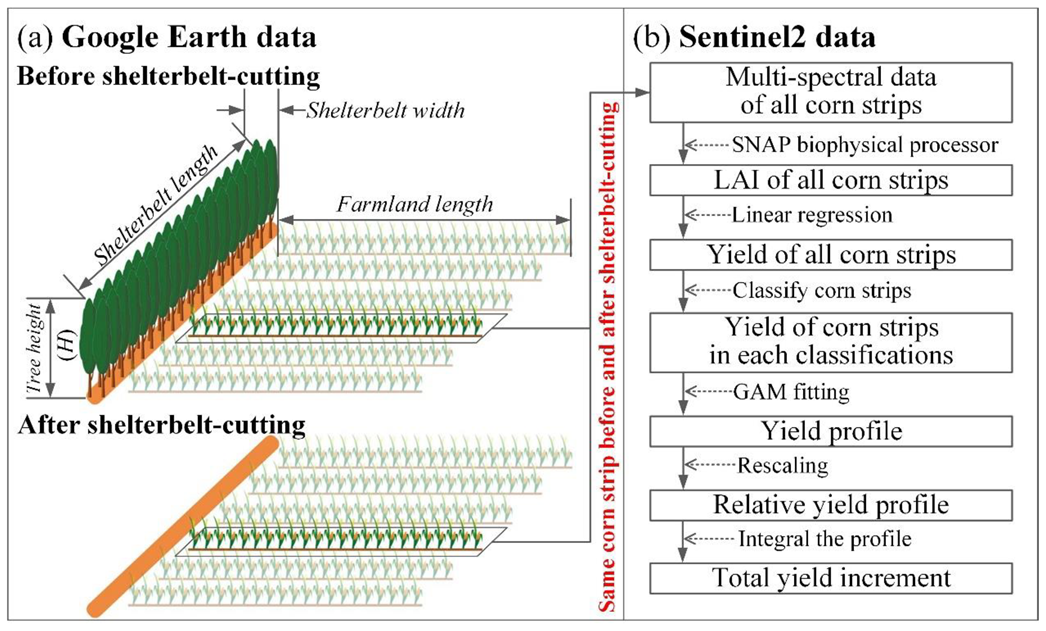
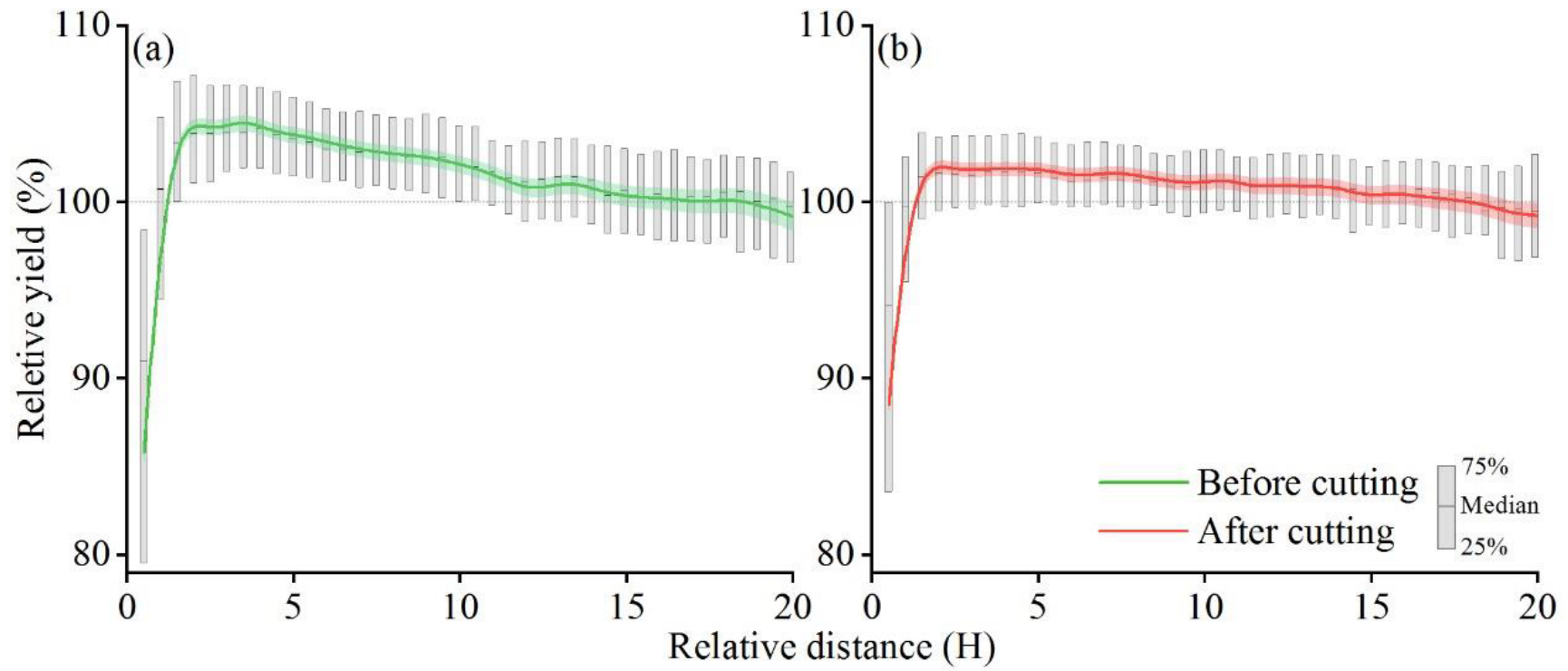
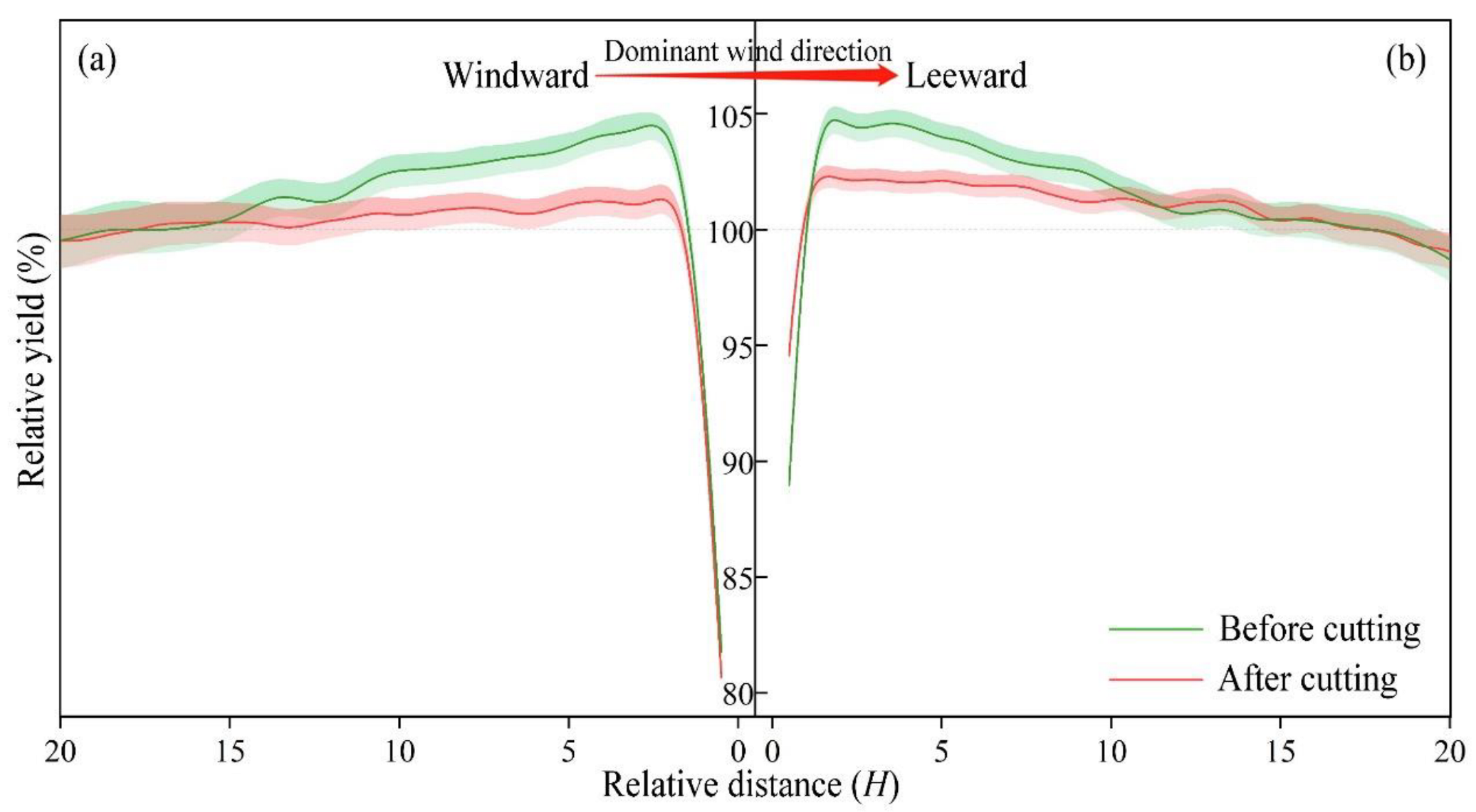
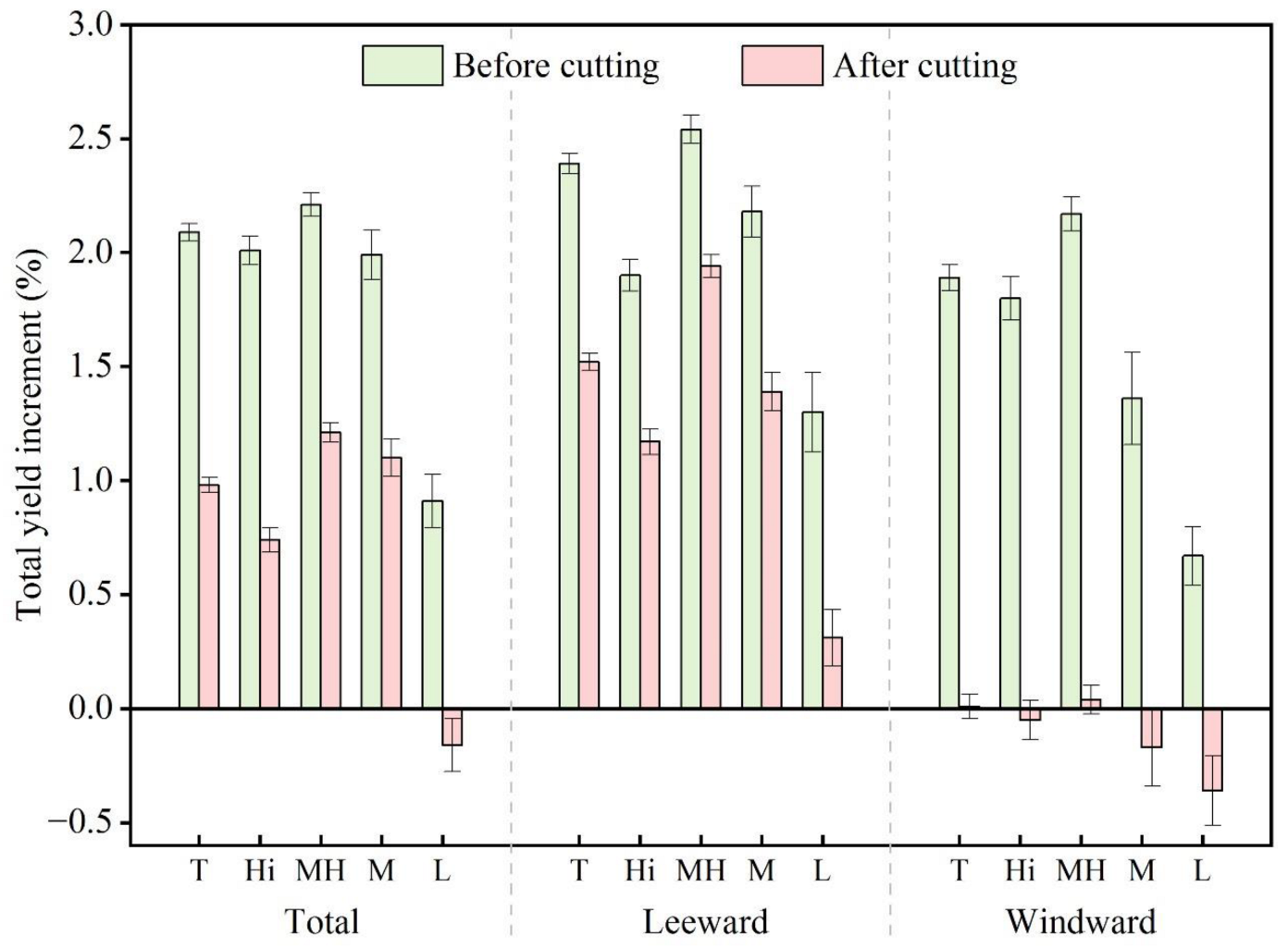
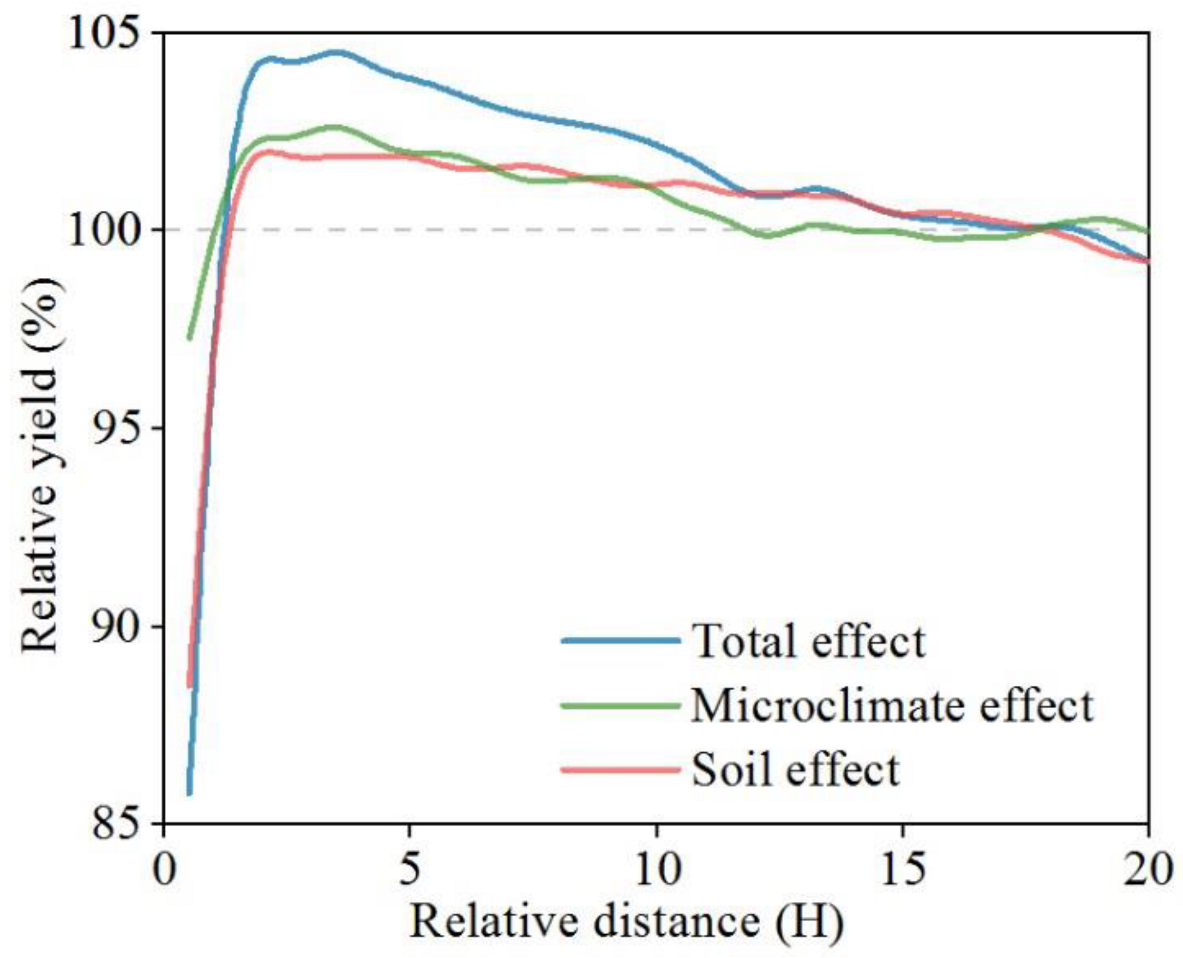
Publisher’s Note: MDPI stays neutral with regard to jurisdictional claims in published maps and institutional affiliations. |
© 2022 by the authors. Licensee MDPI, Basel, Switzerland. This article is an open access article distributed under the terms and conditions of the Creative Commons Attribution (CC BY) license (https://creativecommons.org/licenses/by/4.0/).
Share and Cite
Liu, Y.; Li, H.; Wu, M.; Wang, A.; Wu, J.; Guan, D. Estimating the Legacy Effect of Post-Cutting Shelterbelt on Crop Yield Using Google Earth and Sentinel-2 Data. Remote Sens. 2022, 14, 5005. https://doi.org/10.3390/rs14195005
Liu Y, Li H, Wu M, Wang A, Wu J, Guan D. Estimating the Legacy Effect of Post-Cutting Shelterbelt on Crop Yield Using Google Earth and Sentinel-2 Data. Remote Sensing. 2022; 14(19):5005. https://doi.org/10.3390/rs14195005
Chicago/Turabian StyleLiu, Yage, Huidong Li, Minchao Wu, Anzhi Wang, Jiabing Wu, and Dexin Guan. 2022. "Estimating the Legacy Effect of Post-Cutting Shelterbelt on Crop Yield Using Google Earth and Sentinel-2 Data" Remote Sensing 14, no. 19: 5005. https://doi.org/10.3390/rs14195005
APA StyleLiu, Y., Li, H., Wu, M., Wang, A., Wu, J., & Guan, D. (2022). Estimating the Legacy Effect of Post-Cutting Shelterbelt on Crop Yield Using Google Earth and Sentinel-2 Data. Remote Sensing, 14(19), 5005. https://doi.org/10.3390/rs14195005






